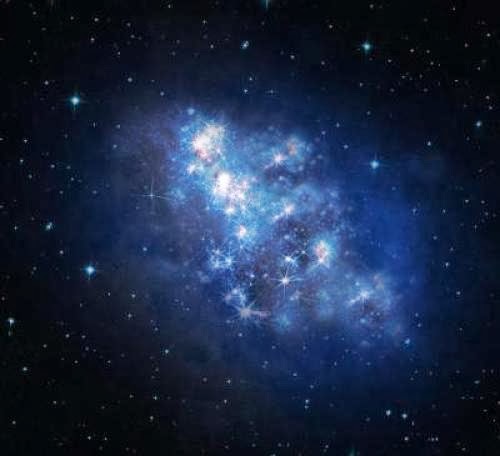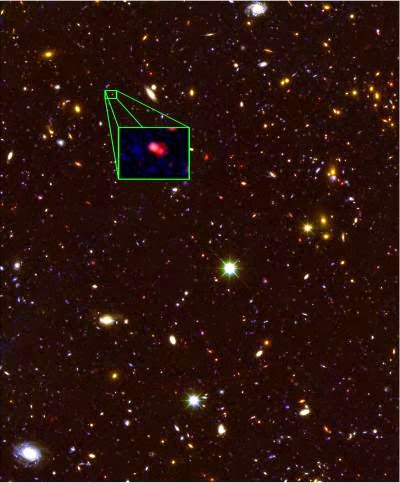

| Visitors Now: | |
| Total Visits: | |
| Total Stories: |

| Story Views | |
| Now: | |
| Last Hour: | |
| Last 24 Hours: | |
| Total: | |
Photo: Oldest Galaxy Yet Found, Formed 700 Million Years After The Big Bang
This is an artist’s rendition of the newly discovered most distant galaxy z8_GND_5296. The galaxy looks red in the actual Hubble Space Telescope image because the collective blue light from stars get shifted toward redder colors due to the expansion of the universe and its large distance from Earth.
In collaboration with astronomers at the University of Texas at Austin, Texas A & M University, and the National Optical Astronomy Observatories, Mobasher and Reddy identified a very distant galaxy candidate using deep optical and infrared images taken by the Hubble Space Telescope. Follow-up observations of this galaxy by the Keck Telescope in Hawai’i confirmed its distance.
In searching for distant galaxies, the team selected several candidates, based on their colors, from the approximately 100,000 galaxies identified in the Hubble Space Telescope images taken as a part of the CANDELS survey, the largest project ever performed by the Hubble Space Telescope, with a total allocated time of roughly 900 hours. However, using colors to sort galaxies is tricky because some nearby objects can masquerade as distant galaxies.
The paper’s lead author is Steven Finkelstein, an assistant professor at the University of Texas at Austin and 2011 Hubble Fellow who previously was a postdoctoral research associate at Texas A&M under the mentorship of Texas A&M astrophysicist Casey Papovich, who is second author as well as current mentor to Tilvi. Ten other international institutions collaborated on the effort, from California to Massachusetts and Italy to Israel.
The galaxy, known by its catalog name z8_GND_5296, fascinated the researchers. Whereas our home, the Milky Way, creates about one or two Sun-like stars every year or so, this newly discovered galaxy forms around 300 a year and was observed by the researchers as it was 13 billion years ago. That’s the time it took for the galaxy’s light to travel to Earth. Just how mind-boggling is that? A single light year, which is the distance light travels in a year, is nearly six trillion miles. Because the universe has been expanding the whole time, the researchers estimate the galaxy’s present distance to be roughly 30 billion light years away.
“Because of its distance we get a glimpse of conditions when the universe was only about 700 million years old — only 5 percent of its current age of 13.8 billion years,” said Papovich, an associate professor in the Department of Physics and Astronomy and a member of the George P. and Cynthia Woods Mitchell Institute for Fundamental Physics and Astronomy since 2008.
Papovich notes that researchers are able to accurately gauge the distances of galaxies by measuring a feature from the ubiquitous element hydrogen called the Lyman alpha transition, which emits brightly in distant galaxies. It’s detected in nearly all galaxies that are seen from a time more than one billion years from the Big Bang, but getting closer than that, the hydrogen emission line, for some reason, becomes increasingly difficult to see.
“We were thrilled to see this galaxy,” Finkelstein said. “And then our next thought was, ‘Why did we not see anything else? We’re using the best instrument on the best telescope with the best galaxy sample. We had the best weather — it was gorgeous. And still, we only saw this emission line from one of our sample of 43 observed galaxies, when we expected to see around six. What’s going on?’”
The researchers suspect they may have zeroed in on the era when the universe made its transition from an opaque state in which most of the hydrogen is neutral to a translucent state in which most of the hydrogen is ionized. So it’s not necessarily that the distant galaxies aren’t there. It could be that they’re hidden from detection behind a wall of neutral hydrogen fog, which blocks the hydrogen emission signal.
Tilvi notes this is one of two major changes in the fundamental essence of the universe since its beginning — the other being a transition from a plasma state to a neutral state. He is leading the effort on a follow-up paper that will use a sophisticated statistical analysis to explore that transition further.
Therefore, to measure the distance to these galaxies in a definitive way, astronomers use spectroscopy — specifically, how much the wavelength of a galaxy’s light has shifted towards the red-end of the spectrum as it travels from the galaxy to Earth, due to the expansion of the universe. This phenomenon is called “redshift.” Since the expansion velocity (redshift) and distances of galaxies are proportional, the redshift gives astronomers a measure of the distance to galaxies.
“What makes this galaxy unique, compared to other such discoveries, is the spectroscopic confirmation of its distance,” said Mobasher, a professor of physics and observational astronomy.
Mobasher explained that because light travels at about 186,000 miles per second, when we look at distant objects, we see them as they appeared in the past. The more distant we push these observations, the farther into the past we can see.
“By observing a galaxy that far back in time, we can study the earliest formation of galaxies,” he said. “By comparing properties of galaxies at different distances, we can explore the evolution of galaxies throughout the age of the universe.”
The discovery was made possible by a new instrument, MOSFIRE, commissioned on the Keck Telescope. Not only is the instrument extremely sensitive, but it is designed to detect infrared light — a region of the spectrum to where the wavelength of light emitted from distant galaxies is shifted — and could target multiple objects at a time. It was the latter feature that allowed the researchers to observe 43 galaxy candidates in only two nights at Keck, and obtain higher quality observations than previous studies.
By performing spectroscopy on these objects, researchers are able to accurately gauge the distances of galaxies by measuring a feature from the ubiquitous element hydrogen called the Lyman alpha transition. It is detected in most galaxies that are seen from a time more than one billion years from the Big Bang, but as astronomers probe earlier in time, the hydrogen emission line, for some reason, becomes increasingly difficult to see.
Of the 43 galaxies observed with MOSFIRE, the research team detected this Lyman alpha feature from only one galaxy, z8-GND-5296, shifted to a redshift of 7.5. The researchers suspect they may have zeroed in on the era when the universe made its transition from an opaque state in which most of the hydrogen is neutral to a translucent state in which most of the hydrogen is ionized (called the Era of Re-ionization).
“The difficulty of detecting the hydrogen emission line does not mean that the galaxies are absent,” said Reddy, an assistant professor of astronomy. “It could be that they are hidden from detection behind a wall of neutral hydrogen.”
The team’s observations showed that z8-GND-5296 is forming stars extremely rapidly — producing each year ~300 times the mass of our sun. By comparison, the Milky Way forms only two to three stars per year. The new distance record-holder lies in the same part of the sky as the previous record-holder (redshift 7.2), which also happens to have a very high rate of star-formation.
“So we’re learning something about the distant universe,” said Steven Finkelstein at the University of Texas at Austin, who led the project. “There are way more regions of very high star formation than we previously thought. There must be a decent number of them if we happen to find two in the same area of the sky.”
“With the construction and commissioning of larger ground-based telescopes — the Thirty Meter Telescope in Hawai’i and Giant Magellan Telescope in Chile — and the 6.5 meter James Webb Space Telescope in space, by the end of this decade we should expect to find many more such galaxies at even larger distances, allowing us to witness the process of galaxy formation as it happens,” Mobasher said.
“It’s exciting to know we’re the first people in the world to see this,” said Vithal Tilvi, a Texas A&M postdoctoral research associate and co-author of the paper, set to be available online at http://dx.doi.org/10.1038/nature12657 after Oct. 24. “It raises interesting questions about the origins and the evolution of the universe.”
Source: http://nanopatentsandinnovations.blogspot.com/2013/10/photo-oldest-galaxy-yet-found-formed.html




